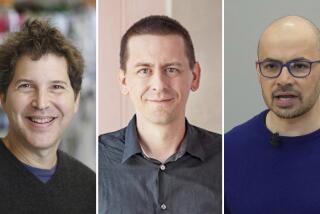Disgruntled PhDs Find Themselves in School of Hard Knocks
- Share via
So you want to be a scientist.
You know the thrill of discovery is tempered by long hours, low pay and stiff competition. Still, you’re not dissuaded. But are you ready to spend years looking for a job?
It’s not that a doctorate is a one-way ticket to Palookaville. Most people who spend four to eight years of their lives earning a science degree can find some kind of job, and frequently a pretty good one. But many wonder afterward if their intensive science training wasn’t a big waste of time.
The profession now offers so few permanent jobs that many promising scientists are bailing out after devoting much of their youth to their studies.
“You spend all those years, and you just throw it all away,” says Zaid Ayer, who recently completed a painful transition from nuclear physics to banking.
Ayer spent his 20s in low-energy nuclear physics, first as a graduate student at Notre Dame, then as a postdoctoral researcher at the University of North Carolina in Chapel Hill. As funding got tighter, he watched the number of labs in the field dwindle to a handful. As older scientists retired or died, he saw their jobs disappear with them.
So in 1995, Ayer transformed himself into a banker by enrolling in a blitzkrieg computational finance program at Pittsburgh’s Carnegie-Mellon University. Now he works as a financial analyst for PNC Bank.
“I don’t look upon it as a waste,” he says of his physics career. “But in the big picture, it really doesn’t get you anywhere.”
After graduation, most young scientists find themselves part of what physicist-turned-geneticist John Quackenbush calls an “intellectual set of migrant workers.”
Young PhDs shuffle between jobs for years, waiting to see if their patience or luck runs out before something permanent comes up. They commonly find themselves in temporary postdoctoral appointments, known as postdocs, for years after graduation.
An academic version of indentured servitude once intended to be a one- or two-year finishing school for research scientists, the postdoc is now a way for the recently graduated to keep themselves alive while searching for a “real” job. National Science Foundation figures show that about one-third of life scientists and 20% of physical scientists are still in postdocs three years after receiving their doctorates.
The popularity of postdocs in recent years has produced what Quackenbush calls a “weird scientific underclass,” toiling long hours for low pay and often no benefits.
“A lot of the people who are actually doing biomedical research are people who don’t have access to medical care because they’re postdocs,” says Quackenbush, who works at the Stanford Human Genome Center in Palo Alto. “It’s a very strange situation.”
Although he does have health insurance, David Sorscher is getting a little nervous after nine years in career limbo. He has held two postdocs since receiving a doctorate from the University of Michigan in 1987 and now is in a quasi-post-postdoc position at the University of North Carolina in Chapel Hill, where he’s welcome to stay until his federal grant runs out.
Over the last nine years, he estimates he’s applied for 50 permanent jobs, but has never even gotten an interview. That’s not unusual--open faculty positions frequently attract hundreds of applications.
“I started in graduate school because I was told that was a good way to be assured of a pretty good job,” Sorscher says “I never expected there would be this kind of situation, this kind of glut of PhD scientists.”
Neither did the government. In 1987, the year Sorscher earned his doctorate., the National Science Foundation gazed into its crystal ball and foresaw a national shortage of scientists early in the 21st century. The agency called for increased efforts to attract talented students to science.
Promulgated just months before the science job market turned sour, the NSF’s forecast made a lot of young scientists confused and bitter about their prospects.
“I grew up under the impression that the U.S. economy valued research scientists, but if I had foreseen the social and economic changes of the last 10 years, I would be doing something else,” says Eric Moser, a physicist who studies superconductivity at a U.S. Air Force research lab in Dayton, Ohio.
The end of the Cold War and the advent of congressional budget balancing have conspired to make the 1990s a very bad decade for scientists. Basic research, once considered vital for maintaining military superiority in the long run, is now perceived in Washington as a luxury.
Federal funding for science has actually decreased slowly since the late 1980s, halting an expansion that began just at the end of World War II.
But new PhDs keep coming through the pipeline. And some of them end up working as software engineers, zookeepers and rodeo stars, says Peter Fiske, author of “To Boldly Go: A Practical Career Guide for Scientists.” In researching that book, Fiske also found people who had left science for business, advertising, law, government and just about every other white-collar profession.
Malcolm Duncan is one of them. In his mid-30s and with no prospects of landing a permanent job in theoretical physics, Duncan “did whatever most people with a bleak outlook on life and a willingness to abase themselves for security do.”
He went to law school.
After getting the British equivalent of a doctorate from Oxford University in 1983, Duncan held five temporary jobs in 12 years. He worked in Michigan, Pennsylvania, Switzerland, Minnesota and Iowa.
During most of that time, Duncan hoped the completion of the superconducting supercollider, a giant particle smasher being constructed in Texas, would revive the job market in his field. The “largest scientific instrument ever built” was to carry physics into a new realm, where current theories would be challenged and new ones developed.
But Congress killed the project in late 1993, leaving a 14-mile tunnel to nowhere beneath the North Texas prairie. Duncan quit his teaching position at the University of Iowa the next year and began applying to law schools. Now he’s in his second year at the University of Minnesota.
“I really liked physics,” Duncan says. “It was something I devoted my life to. But, ultimately, I had to get on with my life.”
The National Science Foundation considers people like Duncan success stories. The agency looks at advanced scientific training as a national asset that can be applied not just in the lab, but in courtrooms, classrooms, boardrooms, at Superfund sites and on Wall Street--anywhere technical knowledge has value.
In May, the science agency’s deputy director, Anne Petersen, summarized the government’s policy in an address to graduating scientists and engineers at the University of Maryland in College Park.
“None of you should define too narrow a role for yourselves in our society,” said Petersen, who since has joined the Kellogg Foundation. “People may say to you, ‘Physicists don’t go into finance, mathematicians don’t enter management and meteorologists don’t pursue public policy.’ I would respond by saying, ‘That’s exactly where we are most needed.’ ”
That attitude upsets a lot of young scientists. After all, nobody tells young medical students they shouldn’t become doctors or advises law school graduates to consider careers in sales.
“The acorn doesn’t fall far from the tree and, in this case, they want the acorn to go across the parking lot,” says John Farrell, who has a doctorate in oceanography and now works as a manager for a consortium of oceanographic research institutions.
The problem is, what works at MIT or UNC doesn’t necessarily translate to IBM or MCI. Nobody disputes that graduate programs at major U.S. universities provide the best training in the world for a career in research science, but their success comes from their intensity--a science doctorate is a mile deep and an inch wide.
As a consequence, many young scientists find themselves on their 30th birthdays highly expert in a specialized field but with no prospects of applying that expertise over a decades-long career and no other skills to fall back on. They can either continue to scrape by, hoping to land something permanent, or they can jump ship.
But starting over at 35 is not so easy. Farrell says his undergraduate liberal arts education gave him the general skills he needed to move from oceanography to managing a nonprofit enterprise, but the nitty-gritty details--how to negotiate a contract, issue safety regulations or manage money--he had to learn on the job.
Education reformer Sheila Tobias recommends addressing that problem with a new type of science graduate degree--basically, a master’s degree without the stigma. In most science disciplines, a master’s is considered either a step on the way to a doctorate or a consolation prize for somebody who couldn’t hack it. Anybody with one is automatically suspect, certainly undertrained for a research career and probably a quitter.
But what the world needs now, Tobias argues, is scientifically trained professionals who can tackle complex, technical problems with objectivity, skepticism and logic. Why not take a year or two to imbue bright young people with those scientific principles, then send them out to apply their knowledge to the world’s problems?
“Somebody’s got to think clearly about what’s needed for the future,” Tobias says “Let’s invent another professional degree that has science in it but is not technically oriented.”
Some universities have tried such programs, Tobias says, but professors don’t like them because they don’t focus on cutting-edge research. And students don’t like them because they have to pay their own way. While the government will pay for a research-oriented education leading to a doctorate, little money is available for a student who wants to apply science to environmental problems, public policy or international development.
But even if new degrees do catch on, policy experts insist that universities are going to have to decrease the number of scientists they produce.
“I know a lot of people around the country--not just in science--are having to deal with this kind of situation, so it might just be something I have to get used to,” says Sorscher, who is 38 and still hasn’t given up hope for a permanent position. “But that doesn’t mean I like it.”






